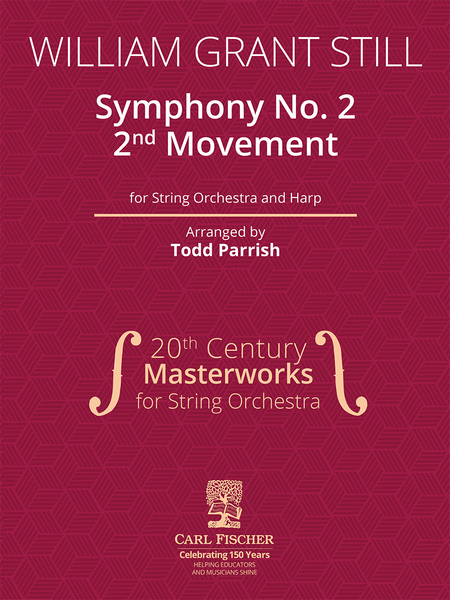Symphony No. 2 - 2nd Mvt
-
Ships in 1 to 2 weeks
Details
Description
SKU: CF.AS144
Composed by William Grant Still. Arranged by Todd Parrish. Set of Score and Parts. 10+2+24+16+10+10+16 pages. Carl Fischer Music #AS144. Published by Carl Fischer Music (CF.AS144).ISBN 9781491160602. UPC: 680160919192.
Often referred to as the "Dean of African American Composers", William Grant Still's illustrious career contained many ground-breaking achievements. Following the massive success of his critically acclaimed Symphony No. 1, the "Afro-American " Symphony (1930), Still's Symphony No. 2 was premiered in 1937 by the Philadelphia Orchestra under the direction of conductor Leopold Stokowski. The work, subtitled "Song of a New Race", infuses elements of blues and jazz into the classical form, creating a uniquely blended sound to reflect Still's vision of an increasingly diverse American culture. Slow, dreamy themes are expressed through lush harmonies utilizing thick textures along with solo and divisi playing. The tension between traditional and jazz idioms is felt in the push and pull of shifting tempo and tonality. Originally composed for Full Orchestra, this slightly abridged version for String Orchestra includes the original harp part, honoring the legacy of one of America's greatest composers.
Often referred to as the "Dean of African American Composers", William Grant Still's illustrious career contained many ground-breaking achievements. Following the massive success of his critically acclaimed Symphony No. 1, the "Afro-American" Symphony (1930), Still's Symphony No. 2 was premiered in 1937 by the Philadelphia Orchestra under the direction of conductor Leopold Stokowski. The work, subtitled "Song of a New Race", infuses elements of blues and jazz into the classical form, creating a uniquely blended sound to reflect Still's vision of an increasingly diverse American culture. Slow, dreamy themes are expressed through lush harmonies utilizing thick textures along with solo and divisi playing. The tension between traditional and jazz idioms is felt in the push and pull of shifting tempo and tonality. Originally composed for Full Orchestra, this slightly abridged version for String Orchestra includes the original harp part, honoring the legacy of one of America's greatest composers.
Often referred to as the "Dean of African American Composers", William Grant Still's illustrious career contained many ground-breaking achievements. Following the massive success of his critically acclaimed Symphony No. 1, the "Afro-American" Symphony (1930), Still's Symphony No. 2 was premiered in 1937 by the Philadelphia Orchestra under the direction of conductor Leopold Stokowski. The work, subtitled "Song of a New Race", infuses elements of blues and jazz into the classical form, creating a uniquely blended sound to reflect Still's vision of an increasingly diverse American culture. Slow, dreamy themes are expressed through lush harmonies utilizing thick textures along with solo and divisi playing. The tension between traditional and jazz idioms is felt in the push and pull of shifting tempo and tonality. Originally composed for full orchestra, this slightly abridged version for string orchestra includes the original harp part, honoring the legacy of one of America's greatest composers.
Often referred to as the “Dean of African American Composers”, William Grant Still’s illustrious career contained many ground-breaking achievements. Following the massive success of his critically acclaimedSymphony No. 1, the "Afro-American" Symphony (1930), Still’s Symphony No. 2 was premiered in 1937 by the Philadelphia Orchestra under the direction of conductor Leopold Stokowski. The work, subtitled “Song of a New Race”, infuses elements of blues and jazz into the classical form, creating a uniquely blended sound to reflect Still’s vision of an increasingly diverse American culture. Slow, dreamy themes are expressed through lush harmonies utilizing thick textures along with solo and divisi playing. The tension between traditional and jazz idioms is felt in the push and pull of shifting tempo and tonality. Originally composed for full orchestra, this slightly abridged version for string orchestra includes the original harppart, honoring the legacy of one of America’s greatest composers.

 Share
Share